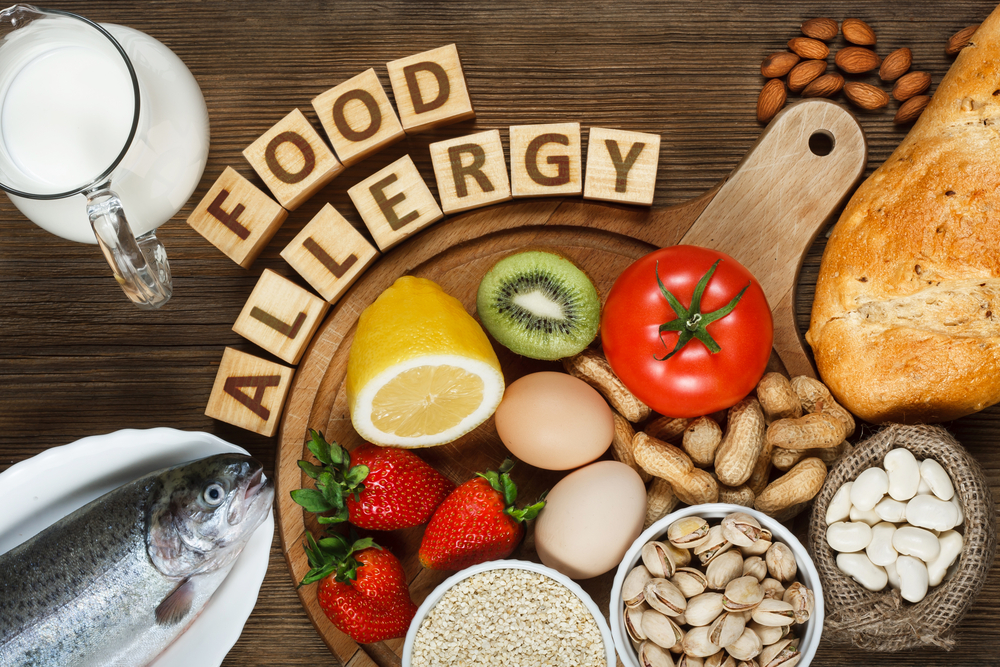Allergies to food, insect stings, medications and latex are most frequently associated with a life-threatening allergic…
Oral Allergy Syndrome (Pollen-Food Allergy Syndrome)

Oral Allergy Syndrome can occur in people with seasonal pollen allergies (hay fever) and is due to cross-reactivity between certain foods and pollens. The most common symptom is an itching or burning sensation in the lips, mouth, ears, or throat upon eating fresh or raw fruits and vegetables. The cooking process usually changes the protein enough so that one can tolerate the food without symptoms. Also, once swallowed, the stomach juices and enzymes degrade the protein rendering it harmless. An epinephrine device is usually not necessary, because this type of allergy is unlikely to progress to anaphylaxis. Symptoms typically resolve without treatment. Individuals may have more food sensitivity during the season when relevant pollens are elevated in air. Some researchers report that Oral Allergy Syndrome can improve with allergen immunotherapy (allergy shots).
See below for list of pollens and the foods that they cross react with.
Symptoms with peanut, tree nuts and soy may be the initial manifestations of a more serious food allergy with potential for anaphylaxis. If such symptoms are noted, evaluation by a board-certified allergist/immunologist is recommended.
Cross reactions have been described for the following foods. Importantly, not all the foods listed below will cause reactions for any one individual:
Birch Pollen
- Includes hazelnut, apple, avocado, peach, pear, peanut, apricot, carrot, celery, cherry, chicory, coriander, fennel, fig, kiwifruit, nectarine, parsley, parsnip, peppers, plum, potato, prune, soy, wheat;
- Potential reaction: almond nut and walnut
Alder Pollen
- Includes almond, apple, celery, cherry, hazel nut, peach, pear, parsley
Grass Pollen
- Includes fig, melon, potato, tomato, orange, Swiss chard, kiwifruit
Mugwort Pollen
- Includes carrot, celery, coriander, fennel, caraway, parsley, peppers, black pepper, sunflower, garlic, onion, mustard, cauliflower, cabbage, paprika, lychee, broccoli
Ragweed Pollen
- Includes banana, cantaloupe, cucumber, honey dew, watermelon, zucchini, echinacea, artichoke, paprika, honey; Potential reaction: Dandelion, hibiscus or chamomile tea
Possible cross-reactions (to any of the above pollens)
- Includes berry (strawberry, blueberry, raspberry, etc), citrus (orange, lemon, etc), grape, mango, fig, peanut, pineapple, pomegranate, watermelon.
References:
https://www.aaaai.org
Nowak-Węgrzyn, A. Clinical manifestations and diagnosis of oral allergy syndrome (pollen-food allergy syndrome). In: UpToDate, Post, TW (Ed), UpToDate, Waltham, MA, 2018.
Nowak-Węgrzyn, A. Management and prognosis of oral allergy syndrome (pollen-food allergy syndrome). In: UpToDate, Post, TW (Ed), UpToDate, Waltham, MA, 2018.
Adkinson, N. Franklin. Middleton’s Allergy: Principles and Practice, Eighth Edition. Elsevier Inc., 2014.
